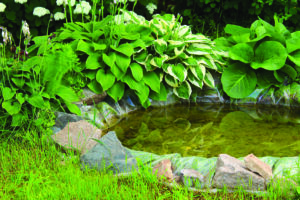
Remember to add water to maintain pond levels and cut back all pond plants and drop them to the bottom of the pond for winter.
Are you ready for autumn’s burst of color? October dazzles with leaf and berry colors as Virginia creeper, maples, oaks, aronia, cotoneaster, fothergilla, hollies and many native plant varieties present us the spectacular shades of reds, oranges, yellows and more.
Asters, Chrysanthemums, pansies and pumpkins help to bring in the shades of fall as well. Just like our landscapes even the autumn sunsets present us with an ever-changing pallet of color.
Empty and clear the rows of vegetables that are finished for the season, and turn the soil by hand or with a roto-tiller.
Remember to dig out and discard any disease or insect-infected garden debris and put in the garbage to prevent any over-wintering issues, other wise consider starting a compost pile.
Fresh organic debris from your yard or garden and the fallen leaves make for the perfect recipe for a compost pile. Remember to keep it watered, provide some lime and turn at least once a week.
Any empty rows in the vegetable garden, consider planting a cover crop of winter rye or wheat to help with erosion and to improve the fertility, texture and the water-holding capacity of the soil for next years growing season.
This month is a good time to assess the health and happiness of your houseplants. Be sure to mist your houseplants twice a week with water at room temperature to help them acclimate to the new changing seasonal home environment.
If you are interested in getting your poinsettia plant to rebloom (color-up) you will need to provide them with 12 hours of light and 12 hours of darkness each day. (This means absolutely no artificial light after dark not even for two or three minutes as this will interrupt the cycle).
Do this for the next two months. Also mix-up a gallon of water soluable fertilizer at half-strength, and use this room temperature mixture when watering, to provide a constant source of feeding.
If your houseplants are out-growing their container be sure to use a pot the next size up for replanting (6-7 inches, etc.).
Use four parts potting soil and one part earthworm castings to help prevent fungal gnats and other insect pests as well as providing much needed organic nutrients.
With the cooling temperatures and the soil still being warm, it is the perfect time to start grass from seed and for re-sodding.
These conditions will be favorable this month and early November.
Digging up, dividing and transplanting overgrown perennials can be done until the first week of December.
Be sure to test the soil for pH and adjust as needed for grass and transplanting. For both the seeding and transplanting also be sure to add compost for organic matter.
Add Milorganite as a starter fertilizer for grass and Biotone Plant starter for transplanting all other plants, to provide the needed nutrients for healthy growing.
When the tree leaves begin to change color, it is an excellent time to transplant and move any rose bushes.
I recommend Biotone plant starter used per label instructions in the bottom of the hole and add composted manure or leafgro to provide the needed organic matter for healthy growing. As the weather cools, stop deadheading and allow the roses to form rose hips.
This will encourage the plant to slow growth and blooming and allow the canes to harden off in preparation for dormancy.
It is also a good idea to apply an anti-desiccant such as Wilt-Pruf to help the rose canes withstand winter dehydration. It is also recommended to us this product on all evergreen shrubs, especially camellias, laurels, rhododendron and even hollies.
Wilt-Pruf prevents tip dryness and leaf discoloration from winter winds and one application in the fall is good for the entire winter season,.
The planting of spring flowering bulbs can continue through this month. Be sure to use Bulbtone or Bonemeal when planting, and plant the bulb at least twice the size of the bulb deep.
Remember that trees, shrubs, grass, bulbs and perennials planted any time this year will need to be watered, especially if we get a fall drought. The root systems are still being developed and established and weekly watering of at last 1 inch of rain or irrigation is necessary for the continued development of a healthy root system.
Prepare your water features and ponds for winter now.
Apply a netting over the pond to keep out leaves and to prevent the pond water from turning brown.
Allowing leaves to settle to the bottom will take the oxygen out of the water as they decompose and create a unhealthy environment for fish. Remember to add water to maintain pond levels and cut back all pond plants and drop them to the bottom of the pond for winter.
Stop feeding fish after water temperature drop below 55 degrees, as their body processes slow and become dormant and they can no longer digest any food.
Treat yourself by taking some time to enjoy the ever-changing autumn colors, the cooler temperatures and the fall harvest of flavors.
(Editor’s Note: Ken Morgan is the owner of Robin’s Nest Floral and Garden Center in Easton, Md.)



